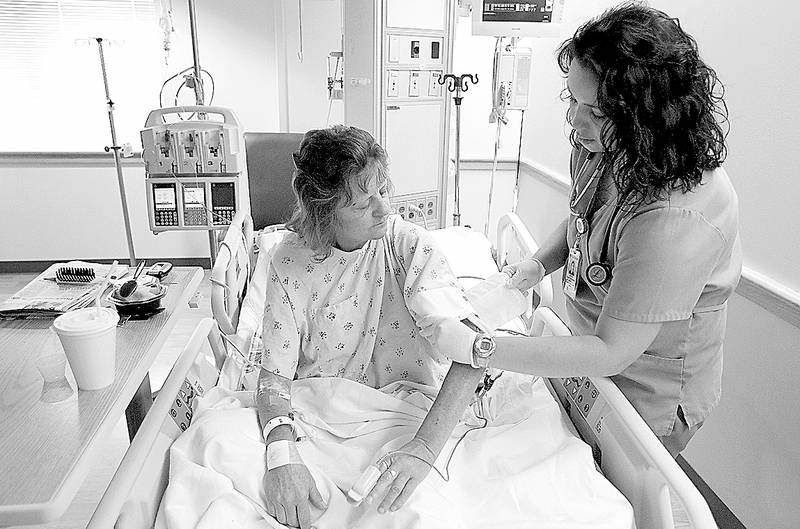Nurse shortage is a looming crisis, but what’s to be done?
Published 5:00 am Friday, July 11, 2008

- Via Christi St. Francis Intensive Care Unit nurse Sofia Jaramillo, right, checks Pammy Coble’s blood pressure. Nearly 9 percent of registered nurse positions at Via Christi are vacant.
WICHITA, Kan. — National nursing organizations have warned for years that the dangerous shortage of hospital nurses is about to get a lot worse, and will eventually kill hospitalized patients. Sofia Jaramillo says this will not happen on her watch if she can help it.
Jaramillo works in a medical intensive care unit at Via Christi Regional Medical Center-St. Francis Campus. A few days ago, two of her patients died of natural causes within 90 minutes of each other, and Jaramillo cried. She said, “I always cry when one of mine dies.”
Trending
Jaramillo works on the front lines of what nurses and doctors here call a national crisis.
American medical groups say the nurse shortage — nearly 9 percent nationally — has burned out nurses, driven many nurses working in acute care out of that specialty, and diminished patient care, just as the baby boom generation has started filling hospital beds.
Laurie Labarca, Via Christi’s interim chief executive, warns the shortage could get worse.
Meanwhile, universities in Kansas are turning away hundreds of qualified nursing students because of a lack of teachers.
Nearly 9 percent of registered nurse positions at Via Christi are vacant.
By her bosses’ own guidelines, Jaramillo should ideally be assigned two patients a night. Sometimes it’s three.
Trending
“On those nights, I just take a deep breath and go,” Jaramillo said. “And I say to myself that nobody’s going to suffer because of me.”
So far, she said, patient safety has not diminished. She does for three what she does for two: dispenses meds in a sequence, checks IVs, helps with procedures; but she has to do it a lot faster, and keep 50 percent more sequences of steps in her head. On most of those 12-hour shifts, she said, she never sits down.
Juanita Tate, who runs the nursing school at Wichita State University, said the shortage is already visible to patients. “You see it every time you punch that call button and no one comes,” she said.
Mary Blubaugh, executive director of the Kansas State Nursing Board, said nurses sometimes tell the regulatory body that they are made to work with too many patients, too little help and with too many nurses assigned temporarily to reinforce some other specialty in which they are not adequately trained. These nurses say this sometimes endangers patients.
“I feel for them,” Blubaugh said, “but when this does happen, nurses have a responsibility to say something.”
The cost of hurrying
What nurses say worries them most is how they might miss a step or two while dispensing meds or doing other tasks. People’s lives are in their hands and their hands are flying.
With the exception of Paul Harrison, a physician and member of Wesley Medical Center’s board of trustees, Wesley officials declined to talk about the shortage, citing a class-action lawsuit recently reinstated against Wesley that contends that it and other hospitals owned by its parent company, the Hospital Corporation of America, deliberately understaffed registered nurses to increase profits.
Wesley lists dozens of nurse jobs vacant on a national employment Web site, www.nationjob .com/wichita/jobs.
The Via Christi Wichita Health Network, which includes the St. Francis and St. Joseph hospital campuses, granted interviews about the shortage — and the many ways they’ve tried to address it. The Eagle interviewed Via Christi’s interim chief executive, chief of nursing and some front-line acute care nurses. They said explaining it to the public would help people understand the coming crisis.
Statewide, Kansas’ 129 hospitals report a vacancy rate of 8.8 percent, about the same as Via Christi’s and the national average.
The strain of the jobs has caused turnover. Via Christi’s annual turnover rate among nurses is 18 percent. Some leave the profession to start families, but others leave to find less stressful jobs in family practice offices, or at specialty hospitals where the load and scheduling from day to night don’t change as much.
The shortage has created a daily juggling act. Via Christi has “house supervisors” like Joye Mock, one of the supervisory nurses, who control the scheduling of every nurse in a Via Christi hospital hour-by-hour, assessing needs and sending reinforcements when needed. Mock watches every unit’s numbers and how sick the patients are in each unit. The sicker the patients, the higher the staffing numbers need to be.
Mock and her staff review numbers and other conditions every four hours, and if necessary will call in extra nurses, approve overtime, call for additional help from an internal resource pool, call in temporary nurses, or switch nurses or patients from one floor to another or even from one Via Christi hospital to another.
“Do we sometimes have uncovered shifts?” asked Saad Ehtisham, Via Christi’s chief nursing officer. “Yes, but we’ve never compromised patient safety.”
Harrison said the shortage of nurses, and of doctors, has made the practice of medicine more demanding.
Acute care teams have so much turnover that they are always training new people, he said.
“A hospital may have an empty bed, but if it doesn’t have a nurse to staff it, that bed doesn’t exist,” he said.
Nurses are stressed, especially in acute care units. “Some of them say they are nearing the end of their rope,” Harrison said.
Statewide, said the nursing board’s Blubaugh, most nurses are in their 40s and 50s. Via Christi officials say the average age of nurses there is 42.
“When this large population of nurses retires, we’re really going to be in trouble,” Blubaugh said.
A Kansas Department of Labor study estimated Kansas will need 11,350 new registered nurses by 2010 to keep up with demand.
That will be hard to do in two years, given that the nursing schools in Kansas produced only 1,761 new nurses last year — and that was a jump from 2004, when only about 1,000 licensed nurses entered the work force.
In 2006, the Legislature approved $3.4 million in grant money to 22 nursing programs in Kansas. WSU got $349,797 last year; $248,387 this year, plus $57,512 in student scholarships.
The money is part of a Kansas Board of Regents’ 10-year, $30 million initiative to increase by 25 percent the capacity of programs to educate registered nurses. While they’re thankful for the extra money, local health care leaders say the new money did not come soon enough.
“We’re human beings, and human beings for whatever reason seem able only to react to a crisis,” Via Christi’s Labarca said.
Grads not enough
Even if nursing schools turn out more graduates in coming years, it won’t be enough, because a lot of nurses quit after their first year or two in nursing, burned out or startled by the number of patients they are assigned, nursing leaders say.
Seventeen percent of Kansans who own a current license as a registered nurse are not practicing, according to the 2004 National Sample Survey of Registered Nurses conducted by the division of nursing at the U.S. Department of Health and Human Services.
Nationally, nurse, doctor and hospital associations are warning that this shortage, combined with a huge doctor shortage and with other shortages in every kind of job in hospitals, is going to endanger a lot of sick and injured people.
Studies conducted by Ivy League institutions such as Harvard and the University of Pennsylvania and reported in the Journal of the American Medical Association and the New England Journal of Medicine back them up.
One such study found that patients who go in for common surgeries at hospitals with high patient-to-nurse ratios could have a roughly 30 percent higher chance of dying than those at hospitals with lower ratios.
“You hear a lot of projections of doom and gloom,” said WSU’s Tate.
“But if you need to go to a hospital, you should go, and you shouldn’t go scared,” she added. “Still, certainly, we know that there are errors made in health care. And we know that when you are overworked and short-staffed, there are more likely to be errors.”
Hospitals in recent years have seen patient populations jump as baby boomers age. Hospitals began offering higher salaries. Just when nursing schools needed them most, faculty members saw that they could go to hospitals and earn two or three times as much as in the classroom.
So many faculty have left, Tate said, that “I feel like I’m running an employment agency here.”








